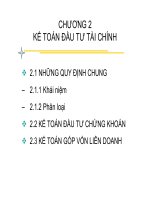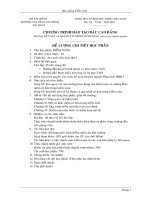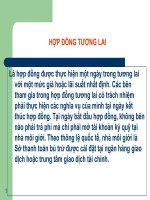ch10 Budgetary Control and Responsibility Accounting Ke toan quan tri
Bạn đang xem bản rút gọn của tài liệu. Xem và tải ngay bản đầy đủ của tài liệu tại đây (2.52 MB, 90 trang )
Page
10-1
Budgetary Control and
Responsibility Accounting
Managerial Accounting
Fifth Edition
Weygandt Kimmel Kieso
Page
10-2
study objectives
1.
Describe the concept of budgetary control.
2.
Evaluate the usefulness of static budget reports.
3.
Explain the development of flexible budgets and the
usefulness of flexible budget reports.
4.
Describe the concept of responsibility accounting.
5.
Indicate the features of responsibility reports for cost
centers.
6.
Identify the content of responsibility reports for profit
centers.
7.
Explain the basis and formula used in evaluating
performance in investment centers.
Page
10-3
preview of chapter 10
Page
10-4
The
The Concept
Concept of
of Budgetary
Budgetary Control
Control
A major function of management is to control
operations.
Takes place by means of budget reports which
compare actual results with planned objectives.
Provides management with feedback on
operations.
Budget reports can be prepared as frequently as
needed.
Analyze differences between actual and
planned results and determines causes.
Page
10-5
SO 1 Describe the concept of budgetary control.
The
The Concept
Concept of
of Budgetary
Budgetary Control
Control
Budgetary control involves the following activities.
Illustration 10-1
Page
10-6
SO 1 Describe the concept of budgetary control.
The
The Concept
Concept of
of Budgetary
Budgetary Control
Control
Works best when a company has a formalized
reporting system which:
Identifies the name of the budget report.
States the frequency of the report.
Specifies the purpose of the report.
Indicates recipient of the report.
Page
10-7
SO 1 Describe the concept of budgetary control.
The
The Concept
Concept of
of Budgetary
Budgetary Control
Control
Partial budgetary control system for manufacturing company.
Illustration 10-2
Note frequency of reports and emphasis on control.
Page
10-8
SO 1 Describe the concept of budgetary control.
The
The Concept
Concept of
of Budgetary
Budgetary Control
Control
Review
Question
Budgetary control involves all but one of the following:
a. Modifying future plans.
b. Analyzing differences.
c. Using static budgets.
d. Determining differences between actual and
planned results.
Page
10-9
SO 1 Describe the concept of budgetary control.
Static
Static Budget
Budget Reports
Reports
When used in budgetary control, each budget
included in master budget is considered to be
static.
A static budget is a projection of budget data
at one level of activity.
Ignores data for different levels of activity.
Compares actual results with budget data at
the activity level used in the master budget.
Page
10-10
SO 2 Evaluate the usefulness of static budget reports.
Static
Static Budget
Budget Reports
Reports
Illustration: Budget and actual sales data for the
Kitchen-Mate product in the first and second quarters of
2011 are as follows.
Illustration 10-3
Page
10-11
SO 2 Evaluate the usefulness of static budget reports.
Static
Static Budget
Budget Reports
Reports
Illustration: Sales budget report for Hayes Company’s
Illustration 10-3
first quarter.
Illustration 10-4
Page
10-12
SO 2 Evaluate the usefulness of static budget reports.
Static
Static Budget
Budget Reports
Reports
Illustration: Budget report for the second quarter. It
contains one new feature: cumulative year-to-date
Illustration 10-3
information.
Illustration 10-5
Page
10-13
SO 2 Evaluate the usefulness of static budget reports.
Static
Static Budget
Budget Reports
Reports
Uses and Limitations
Appropriate for evaluating a manager’s
effectiveness in controlling costs when:
Actual level of activity closely
approximates master budget
activity level.
Behavior of costs is fixed in
response to changes in activity.
Appropriate for fixed costs.
Not appropriate for variable costs.
Page
10-14
SO 2 Evaluate the usefulness of static budget reports.
Static
Static Budget
Budget Reports
Reports
Review
Question
A static budget is useful in controlling costs
when cost behavior is:
a. Mixed.
b. Fixed.
c. Variable.
d. Linear.
Page
10-15
SO 2 Evaluate the usefulness of static budget reports.
Flexible
Flexible Budgets
Budgets
Budgetary process more useful if it is
adaptable to changes in operating
conditions.
Projects budget data for various levels of
activity.
Essentially, a series of static budgets at
different activity levels.
Can be prepared for each type of budget in
the master budget.
Page
10-16
SO 3 Explain the development of flexible budgets
and the usefulness of flexible budget reports.
Flexible
Flexible Budgets
Budgets
Uses and Limitations
Illustration: Barton Steel, static budget based on a
production volume of 10,000 units of steel ingots.
Illustration 10-6
Page
10-17
SO 3
Flexible
Flexible Budgets
Budgets
Illustration: Overhead Static Budget report assuming
12,000 units were actually produced.
Illustration 10-7
Page
10-18
SO 3
Flexible
Flexible Budgets
Budgets
Very large variances due to increased demand for
steel ingots.
Unfavorable difference of $132,000 – 12% over
budget.
Comparison based on budget data for 10,000 units the original activity level which is not relevant.
Page
10-19
Meaningless to compare actual variable costs for
12,000 units with budgeted variable costs for 10,000
units.
Budgeted
should
Variable
cost variable
increase amounts
with production.
increase proportionately with production
SO 3
Flexible
Flexible Budgets
Budgets
Illustration: Analyzing the budget data for these costs
at 10,000 units, you arrive at the following per unit
results.
Illustration 10-8
Illustration 10-9
Budgeted
variable costs
at 12,000
units.
Page
10-20
SO 3
Flexible
Flexible Budgets
Budgets
Illustration: Prepare the budget report based on the
flexible budget for 12,000 units of production.
Illustration 10-10
Page
10-21
SO 3
Flexible
Flexible Budgets
Budgets
Developing the Flexible
Budget
Identify the activity index and the relevant range
of activity.
Identify the variable costs and determine the
budgeted variable cost per unit of activity for
each cost.
Identify the fixed costs and determine the
budgeted amount for each cost.
Prepare the budget for selected increments of
activity within the relevant range.
Page
10-22
SO 3 Explain the development of flexible budgets
and the usefulness of flexible budget reports.
Flexible
Flexible Budgets
Budgets
Flexible Budget – A Case
Study
Illustration: Fox Manufacturing Company’s
management uses a flexible budget for monthly
comparisons of actual and budgeted manufacturing
overhead costs of the Finishing department. The master
budget for the year ending December 31, 2011, shows
expected annual operating capacity of 120,000 direct
Illustration 10-11
labor hours and the following overhead costs.
Page
10-23
SO 3 Explain the development of flexible budgets
and the usefulness of flexible budget reports.
Flexible
Flexible Budgets
Budgets
Four steps for developing the flexible budget.
Identify the activity index and the relevant range.
Activity index: direct labor hours.
Relevant range: 8,000 – 12,000 direct labor hours
per month.
Identify variable costs and determine the
budgeted variable cost per unit of activity for each
cost.
Illustration 10-12
Page
10-24
SO 3
Flexible
Flexible Budgets
Budgets
Four steps for developing the flexible budget.
Identify the fixed costs and determine the
budgeted amount for each cost.
Three fixed costs per month:
Depreciation $15,000.
Property taxes $5,000.
Supervision $10,000.
Prepare the budget for selected increments of
activity within the relevant range.
Page
10-25
Prepared in increments of 1,000 direct labor hours.
SO 3









